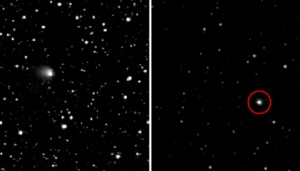The comet being chased by the long-traveling spacecraft only woke briefly before starting another nap.
Comets can be finicky. In April and May Comet 67P/Churyumov-Gerasimenko seemed to have woken up, growing a coma of water ice, carbon dioxide, and other volatiles.

ESA / Rosetta / MPS for OSIRIS Team MPS / UPD / LAM / IAA / SSO / INTA / UPM / DASP / IDA
But earlier this month the comet’s nucleus showed no signs of its extended coma, as shown in this image from one of the OSIRIS cameras on ESA’s Rosetta spacecraft. The little nucleus (about 4 kilometers/2.5 miles wide) is probably not truly bare — there might be low-level activity and a thin coma that can’t be detected from Rosetta’s distance (430,000 km at the time of this image on June 4th).
This isn’t surprising, explains mission team member Joel Parker (Southwest Research Institute). The comet probably sputters when starting up during each orbit, kind of like a car engine that turns over several times before starting. Because the previous activity was temporary, it bodes well for the approaching Rosetta: the spacecraft will be able to watch the onset of full-fledged coma growth from close up.
Rosetta will rendezvous with Comet Churyumov-Gerasimenko in August and escort it for more than a year through its solar pass. If you’d like to know more about the mission (and the nail-biting wait for the spacecraft to phone home), check out Parker’s cover story on Rosetta in our August 2014 issue, which is now available as a digital issue and should be on newsstands shortly (subscribers should receive it soon, if they haven’t already).
 2
2









Comments
Anthony Barreiro
June 26, 2014 at 6:03 pm
I've started thinking of "comet" as more of a verb than a noun. When an object starts emitting a great deal of gas and dust, it is "cometing". Objects that have more eccentric orbits that pass close to the Sun are more likely to comet than are those with more circular orbits that never approach the Sun. But even objects that never leave the asteroid belt have been observed to comet.
You must be logged in to post a comment.
James-Watts
June 28, 2014 at 12:39 am
That's a really good idea! (IMHO) It would stop the arguments about whether a previously classified "asteroid" should be reclassified as a "comet" after it was observed to show some "cometing"
You must be logged in to post a comment.
You must be logged in to post a comment.